Sasebo Naval District
Sasebo Naval District (佐世保鎮守府, Sasebo chinjufu) was the third of five main administrative districts of the pre-war Imperial Japanese Navy. Its territory included the western and southern coastline of Kyūshū, the Ryukyu Islands, Taiwan and Korea, as well as patrols in the East China Sea and the Pacific
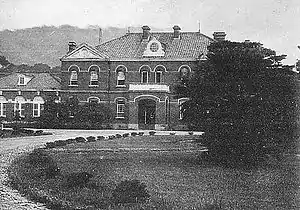
Sasebo also contained the Sasebo Naval Arsenal, specializing mostly in destroyers and smaller warships; and its anchorage was one of the largest in Japan. The District encompassed anchorages at Imari and Hirado ports as well as the designated third echelon naval ports yokobu (要港部) of Takeshiki (Tsushima), Kagoshima, Kuji (Amami-Ōshima), and Wakamatsu (Gotō Islands)
History
The location of Sasebo 33°10′05″N 129°44′06″E facing China and Korea, and near the foreign treaty port of Nagasaki was recognized of strategic importance by the leaders of the early Meiji government and early Imperial Japanese Navy. In 1883, the then Lieutenant Commander Tōgō Heihachirō nominated what was a tiny fishing village as the ideal location for a naval base. With the formation of the navy in 1886, Japan was divided into five Naval Districts (海軍区) each with a headquarters (鎮守府). Sasebo was designated as the "Third Naval District" (第三海軍区, dai-san kaigunku), and its harbor was dredged, a breakwater constructed and docking, coaling and repair facilities for warships were established, and the military base was officially opened in 1889. To stress the importance of the base, Emperor Meiji made a personal inspection tour in 1890.
The base was connected to the rest of Japan by rail in 1898, and the Sasebo Naval Arsenal, which would eventually expand to become one of the largest shipyards in Japan for the construction of smaller warships, began operation in 1903. As with the other Naval Districts, Sasebo was intended to operate as independently as possible, and facilities included armories, production factories for torpedoes, naval mines and naval artillery (and associated ammunition), and also a naval hospital and training centers. In concept, the Naval District was similar to the United States Navy Sea Frontiers concept. the Naval District maintained a small garrison force of ships and Naval Land Forces which reported directly to the Guard District commander, and hosted detachments of the numbered fleets on a temporary assignment basis.
Sasebo was the closest ship repair facility for the Imperial Japanese Navy to the combat zones of the Russo-Japanese War and saw considerable activity during that conflict.
In 1920, the Japanese navy established an air wing and a wireless communications center in 1922. In 1934, the Tomozuru capsized off Sasebo with loss of most of its crew, and leaving behind serious questions about the basic design of many Japanese warships.
In 1941, base facilities were expanded considerably for the Pacific War. The base also hosted a major portion of the Japanese Special Naval Landing Forces. The Imperial Japanese Navy had some 60,000 people working in the dock yard and associated naval stations at the peak of World War II, outfitting ships, submarines and aircraft.
Most of the base was destroyed by American air raids on Japan on June 28, 1945. After the surrender of Japan, Sasebo was occupied by the U.S. Marine Corps' Fifth Division, and the Sasebo Naval District was formally abolished on November 30, 1945.
Part of the former base facilities is still in use by the United States Navy as the United States Fleet Activities Sasebo and by the Japan Maritime Self-Defense Force. One of the former base structures is now a museum.
Order of Battle at time of the attack on Pearl Harbor
- Third Naval District (Admiral Tanimoto)
- AO Sata
- Sasebo Naval Base
- Base HQ
- Communications
- Supply
- Accounting
- Construction
- Ports & Docks
- Navy Yard
- Navy Hospital
- Navy Prison
- Naval Fuel Depot
- Base Garrison
- Special Naval Landing Forces
- Sasebo Submarine Base
- Sasebo Air Group
- 16x Mitsubishi A5M Claude
- 6 x Aichi E13A Jake
- 15 x Kawanishi H6K Mavis
- Sasebo Guard Force
- Sasebo Coastal Defense Squadron
- PM Kozan Maru
- Sasebo Local Defense Squadron
- PG Shinkyo Maru (2672 tons)
- PG Shinkyo Maru #5
- Minesweeper Division 42
- AMc Seki Maru (297 tons)
- AMc Toshi Maru #7 (297 tons)
- Sasebo Coastal Defense Squadron
- Oshima Guard Force (based at Naze, Oshima Island)
- AMc Chuon Maru #8
- AMc Hakata Maru #7 (257 tons)
- AMc Himejima Maru
- Minesweeper Division 41
- AMc Kyo Maru #1
- AMc Kyo Maru #3
- AMc Kyo Maru #5
List of commanders
Commanding officers
| No. | Name | Portrait | Rank | Term of Office | |
|---|---|---|---|---|---|
| Start | End | ||||
| 1 | Akamatsu Noriyoshi |  |
Vice Admiral | 26 September 1887 | 27 June 1891 |
| 2 | Abo Kiyoyasu |  |
Vice Admiral | 27 June 1891 | 12 December 1892 |
| 3 | Inoue Yoshika |  |
Vice Admiral | 12 December 1892 | 20 May 1893 |
| 4 | Aiura Norimichi |  |
Rear Admiral | 20 May 1893 | 13 July 1894 |
| 5 | Shibayama Yahachi |  |
Rear Admiral
Vice Admiral (after 7 October 1897) |
13 July 1894 | 8 October 1897 |
| 6 | Aiura Norimichi |  |
Vice Admiral | 8 October 1897 | 19 January 1899 |
| 7 | Tōgō Heihachirō | 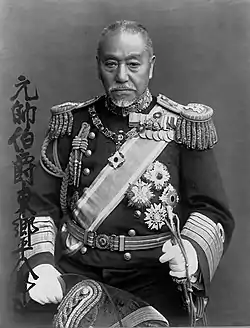 |
Vice Admiral | 19 January 1899 | 20 May 1900 |
| 8 | Samejima Kazunori |  |
Vice Admiral
Admiral (after 18 November 1905) |
20 May 1900 | 2 February 1906 |
| 9 | Arima Shinichi |  |
Vice Admiral | 2 February 1906 | 22 November 1906 |
| 10 | Uryū Sotokichi | 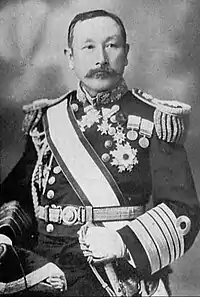 |
Vice Admiral | 22 November 1906 | 1 March 1909 |
| 11 | Arima Shinichi |  |
Vice Admiral | 1 March 1909 | 1 December 1909 |
| 12 | Dewa Shigetō | 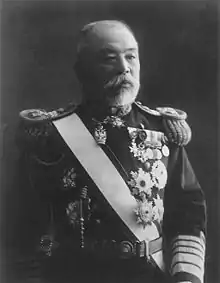 |
Vice Admiral | 1 December 1909 | 1 December 1911 |
| 13 | Shimamura Hayao |  |
Vice Admiral | 1 December 1911 | 25 March 1914 |
| 14 | Fujii Kōichi | 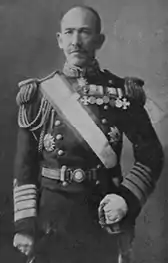 |
Vice Admiral | 25 March 1914 | 10 August 1915 |
| 15 | Yamashita Gentarō |  |
Vice Admiral | 10 August 1915 | 1 December 1917 |
| 16 | Yashiro Rokurō | 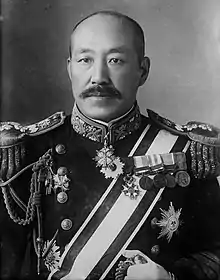 |
Vice Admiral
Admiral (after 2 July 1918) |
1 December 1917 | 1 December 1918 |
| 17 | Takarabe Takeshi |  |
Vice Admiral
Admiral (after 25 November 1919) |
1 December 1918 | 27 July 1922 |
| 18 | Tochinai Sōjirō |  |
Admiral | 27 July 1922 | 1 June 1923 |
| 19 | Saitō Hanroku | 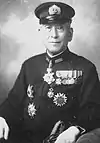 |
Vice Admiral | 1 June 1923 | 5 February 1924 |
| 20 | Prince Fushimi Hiroyasu | 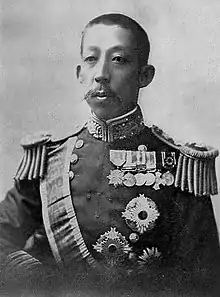 |
Admiral | 5 February 1924 | 15 April 1925 |
| 21 | Hyakutake Saburō | 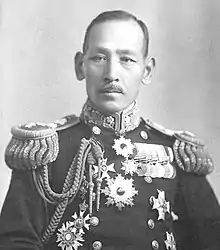 |
Vice Admiral | 15 April 1925 | 10 December 1926 |
| 22 | Furukawa Shinzaburō |  |
Vice Admiral | 10 December 1926 | 12 October 1928 |
| 23 | Iida Nobutarō |  |
Vice Admiral | 12 October 1928 | 11 November 1929 |
| 24 | Tosu Tamaki |  |
Vice Admiral | 11 November 1929 | 1 December 1930 |
| 25 | Yamanashi Katsunoshin |  |
Vice Admiral | 1 December 1930 | 1 December 1931 |
| 26 | Nakamura Ryōzō |  |
Vice Admiral | 1 December 1931 | 1 December 1932 |
| 27 | Sakonji Seizō |  |
Vice Admiral | 1 December 1932 | 15 November 1933 |
| 28 | Yonai Mitsumasa |  |
Vice Admiral | 15 November 1933 | 15 November 1934 |
| 29 | Imamura Nobujirō |  |
Vice Admiral | 15 November 1934 | 2 December 1935 |
| 30 | Hyakutake Gengo | 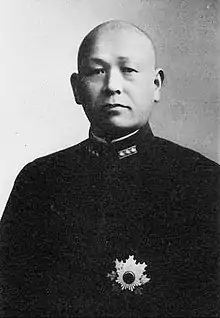 |
Vice Admiral | 2 December 1935 | 16 March 1936 |
| 31 | Matsushita Hajime |  |
Vice Admiral | 16 March 1936 | 1 December 1936 |
| 32 | Shiozawa Kōichi | 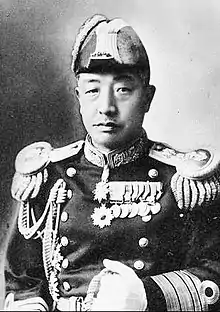 |
Vice Admiral | 1 December 1936 | 1 December 1937 |
| 33 | Toyoda Teijirō | 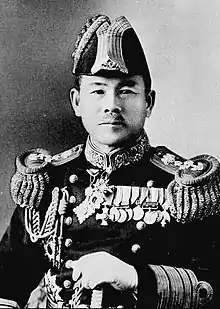 |
Vice Admiral | 1 December 1937 | 15 November 1938 |
| 34 | Nakamura Kamezaburō |  |
Vice Admiral | 15 November 1938 | 15 November 1939 |
| 35 | Hirata Noboru |  |
Vice Admiral | 15 November 1939 | 15 October 1940 |
| 36 | Sumiyama Tokutarō |  |
Vice Admiral | 15 October 1940 | 20 November 1941 |
| 37 | Tanimoto Matarō |  |
Vice Admiral | 20 November 1941 | 11 November 1942 |
| 38 | Nagumo Chūichi | 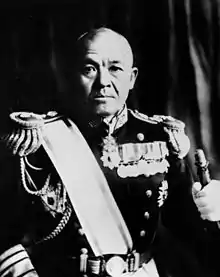 |
Vice Admiral | 11 November 1942 | 21 June 1943 |
| 39 | Komatsu Teruhisa | 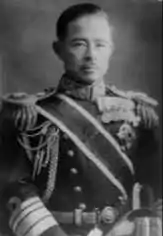 |
Vice Admiral | 21 June 1943 | 4 November 1944 |
| 40 | Sugiyama Rokuzō |  |
Vice Admiral | 4 November 1944 | 30 November 1945 |
Chief of Staff
- Captain Tameo Nakamizo (April 25, 1889 – May 15, 1890)
- Rear-Admiral Koreyoshi Ogata (May 15, 1890 – February 18, 1891)
- Rear-Admiral Masanaga Matsumura (February 18, 1891 – July 23, 1891)
- Rear-Admiral Tadashi Nomura (July 23, 1891 – May 20, 1893)
- Vice-Admiral Nagataka Uemura (May 20, 1893 – December 5, 1894)
- Vice-Admiral Tomomichi Onomoto (December 5, 1894 – December 27, 1897)
- Vice-Admiral Yoshitomo Inoue (December 27, 1897 – May 23, 1898)
- Captain Masaki Hashimoto (May 23, 1898 – March 22, 1899)
- Rear-Admiral Ichiro Nijima (March 22, 1899 – June 19, 1900)
- Rear-Admiral Tasuku Serata (June 19, 1900 – July 4, 1900)
- Admiral Motaro Yoshimatsu (July 4, 1900 – July 6, 1901)
- Vice-Admiral Hikohachi Yamada (July 6, 1901 – October 19, 1903)
- Rear-Admiral Shinjiro Uehara (November 21, 1903 – June 6, 1904)
- Vice-Admiral Baron Toshiatsu Sakamoto (June 6, 1904 – November 2, 1905)
- Admiral Motaro Yoshimatsu (November 2, 1905 – February 2, 1906)
- Rear-Admiral Ichiro Nijima (February 2, 1906 – April 7, 1906)
- Vice-Admiral Koshi Saito (April 7, 1906 – October 21, 1907)
- Rear-Admiral Genzaburo Ogi (October 21, 1907 – May 15, 1908)
- Vice-Admiral Baron Shinrokuro Nishi (May 15, 1908 – May 26, 1908)
- Vice-Admiral Tamotsu Tsuchiya (May 26, 1908 – December 10, 1908)
- Admiral Baron Gentaro Yamashita (December 10, 1908 – March 4, 1909)
- Rear-Admiral Genzaburo Ogi (March 4, 1909 – December 1, 1909)
- Vice-Admiral Yasutaro Egashira (December 1, 1909 – March 11, 1911)
- Admiral Kaneo Nomaguchi (March 11, 1911 – September 21, 1911)
- Vice-Admiral Rinroku Eguchi (September 21, 1911 – April 20, 1912)
- Vice-Admiral Otojiro Ito (April 20, 1912 – December 1, 1913)
- Rear-Admiral Ichitaro Nakajima (December 1, 1913 – March 25, 1914)
- Vice-Admiral Tomojiro Chisaka (March 25, 1914 – December 1, 1914)
- Vice-Admiral Hiromi Tadakoro (December 1, 1914 – December 1, 1916)
- Vice-Admiral Hanroku Saito (December 1, 1916 – December 1, 1917)
- Vice-Admiral Nobutaro Shimomura (December 1, 1917 – November 10, 1918)
- Admiral Saburo Hyakutake (November 10, 1918 – December 1, 1919)
- Vice-Admiral Kenzo Kobayashi (December 1, 1919 – May 1, 1922)
- Rear-Admiral Kametaro Muta (May 1, 1922 – December 1, 1923)
- Vice-Admiral Shiro Furukawa (December 1, 1923 – December 1, 1925)
- Vice-Admiral Yukichi Shima (December 1, 1925 – December 1, 1927)
- Vice-Admiral Togo Kawano (December 1, 1927 – December 10, 1928)
- Vice-Admiral Akira Fujiyoshi (December 10, 1928 – December 1, 1930)
- Vice-Admiral Giichiro Kawamura (December 1, 1930 – December 1, 1931)
- Vice-Admiral Yoshiyuki Niiyama (December 1, 1931 – November 15, 1933)
- Vice-Admiral Eikichi Katagiri (November 15, 1933 – November 15, 1934)
- Rear-Admiral Hiroyoshi Tabata (November 15, 1934 – March 1, 1935)
- Vice-Admiral Ibō Takahashi (March 1, 1935 – October 31, 1935)
- Vice-Admiral Mitsumi Shimizu (October 31, 1935 – November 16, 1936)
- Vice-Admiral Hidesaburo Koori (November 16, 1936 – September 1, 1938)
- Vice-Admiral Masami Kobayashi (September 1, 1938 – November 15, 1939)
- Vice-Admiral Kakuji Kakuta (November 15, 1939 – October 15, 1940)
- Vice-Admiral Shigenori Horiuchi (October 15, 1940 – October 10, 1941)
- Vice-Admiral Gisaburo Yamaguchi (October 10, 1941 – December 2, 1942)
- Vice-Admiral Masaki Ogata (December 2, 1942 – November 15, 1943)
- Vice-Admiral Shigeji Kaneko (November 15, 1943 – January 29, 1945)
- Rear-Admiral Keishi Ishii (January 29, 1945 – November 30, 1945)
References
- Prados, John (1995). Combined Fleet Decoded: The Secret History of American Intelligence and the Japanese Navy in World War II. Annapolis: Naval Institute Press. ISBN 0-460-02474-4.
- Order of Battle at start of Pacific War